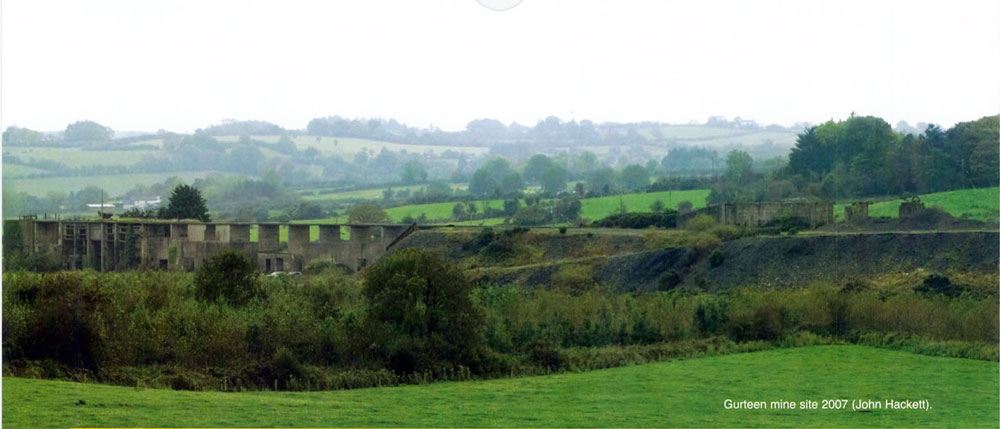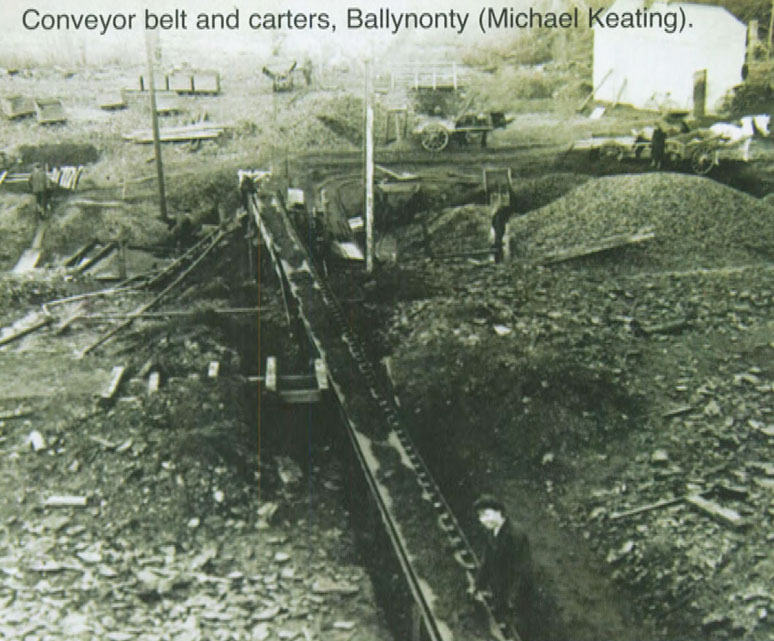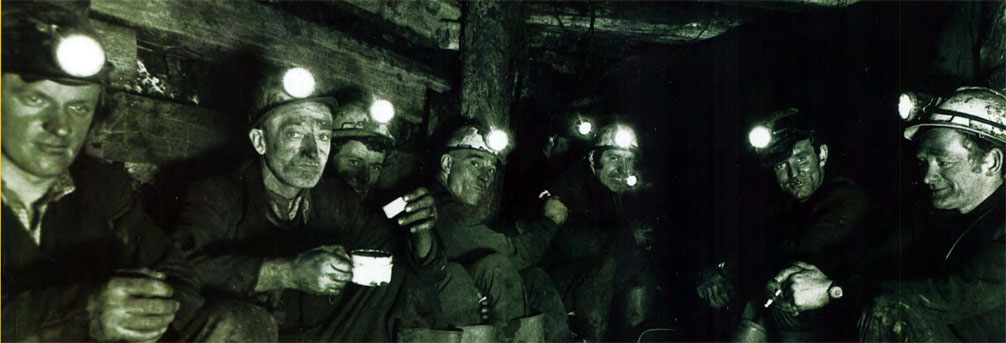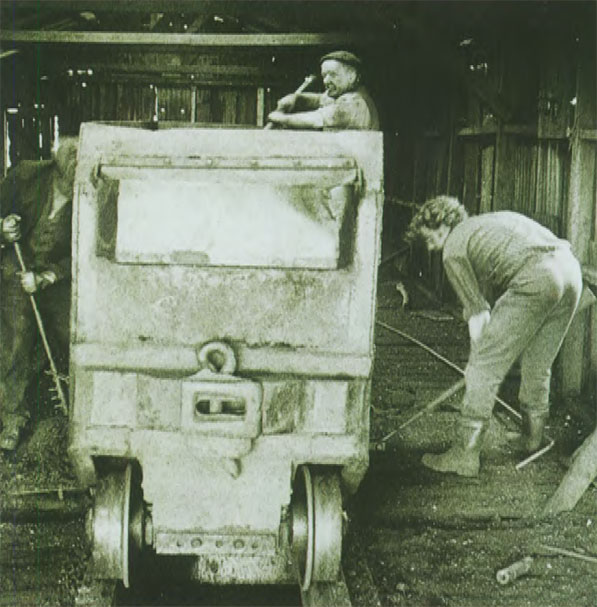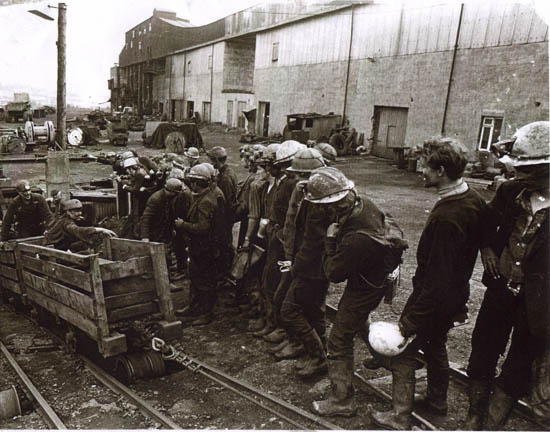Gurteen
According to tradition, coal mining has taken place in this area for at least 400 years. It is recorded in the civil survey of 1654 that coal was being mined which was “suitable for blacksmiths at (cúl na choille) Coolquill. Indeed local folklore suggests the Danes mined the coal during their “visit” in the 11th century. Until 1825 the mines were worked almost exclusively by unlicensed private enterprise, Farmers large and small on whose land seam outcropping occurred. It is recorded that 35 mines were in production employing about 1000 men through the early part of the 1800’s.
As in England mining was carried out in Slieveardagh by the landowners, such as the Goings, Langleys, Barker-Ponsonbys and Vere Hunt through the late eighteenth and early nineteenth centuries. Ballyphillip House was the residence of the Goings who worked Earlshill colliery before leasing it to the Mining Company of Ireland. The house was demolished in the 1930s. Coalbrook House, was the residence of the Langley family, who had collieries at Lisnamrock, The Acres and Knockalonga. This family also leased rights to the Mining Company but began small-scale mining again after its demise. Kilcooley House belonged to the Ponsonby family whose mining interests were located to the east of the field.
Richard Sutcliffe, who worked a mine in Kilcooley in 1883, emigrated to Wakefield, England where he developed the first coal cutting machine and underground conveyor system. Vere Hunt, who lived at Sherbourne House on his Glengoole Estate, has left a vivid account of his coal mining enterprises on the hills above his residence in the early decade of the nineteenth century. The Mining Company of Ireland erected Coalfield House at The Commons for its manager in the 1850s. Thomas O’Brien invested the profits from the Gurteen enterprise in the 1950s in purchasing the imposing Woodrooff House near Clonmel.
Copper ‘steeple’ built in 1863 is a landmark and a remarkable example of both the stone-mason’s craft and design technique. Its builders were Edmund and Michael Kenny of Curaheenduff and it is 96 feet in height. There is no record of an engine house or coalmine on the site. Knockalonga was developed in 1873 when an engine house and accommodation (The Culmyard) for workmen were erected. The engine house differed from that in Mardyke in that the power of the engine was transferred through the rocking motion of the cast iron beam to a wheel by cranks, thus allowing the engine drive machinery or a winding mechanism. The chimneys at both Knockalonga and Copper are square rather than circular.
Mining in Slievardagh was localised and small scale in the years from 1900 to 1940. But the outbreak of World War Two disrupted coal imports to Ireland and focused attention on native resources. In May 1941 the Sllevardagh Coalfield Development Company was formed but was superseded by Mianrai Teoranta in June 1945. Ballynonty was developed north of Mardyke in the former demesne of the Going Estate, despite local opinion that better prospects were present at the centre of the basin. At its peak Ballynonty mine employed 170 men and had a hostel for 80 men. The photographic record, by Michael Keating, Clonmel, of the mine’s development is an unique source. It was the first Slievardagh mine to use electricity for powering haulage and pumping of water but the colliers still worked in bad conditions. Another innovation was that candles were replaced by carbide lamps to provide light underground.
In 1941 a State mining company called Mianraí Teoranta was established and, along with a number of other ventures around the country, acquired the rights to develop the Slieveardagh Coalfields under the authority of the Minister of Industry and Commerce. The Slieveardagh Coalfield Development Bill, 1941 was introduced in the Daíl and passed on April 3rd 1941. A mine was opened in Ballynonty in August of the same year employing up to 100 men. The manager was a man named Mr. McGlucky from Scotland. They also worked in Lickfinn and continued during the war years but found both projects uneconomic and they were abandoned in favour of the Copper basin in September 1948. This transition took some months as they had to move the entire operation, including buildings, machinery etc. Not long after its’ establishment, Copper Colliery was renamed Clashduff Colliery in order “to avoid confusion with the metal”! Then in January 1949 it was again renamed Ballingarry Colliery.
By 1950 the mines were again operating at a loss and a Mayo man, Mr. Tommy O’Brien is reported to have purchased the ailing operation from the state in February 1952 for £50,000. Apparently he had cleared his outlay within 12 months, having disposed of the huge amounts of mine deposits on the surface, installed new pumping equipment to overcome flooding and discovered a new seam of top quality anthracite.
Most of its coal went to the ESB to power their plants to provide electricity. It was the second commercial mines in Slieveardagh. Miners from all over came to work there from, Kilkenny, Callan, Urlingford, Killmanagh, Tullaroan,Galmoy, Killenaule, Ballingarry, Ballantaggart, Gortnahoe and New Bermingham, There were several accidents two in particularly in 1951. In June 1951 one miner was killed when a rock fell from the roof where he was working. In the same year 1951 in September brother was killed in an explosion, one brother was badly injured but survived. All four been brothers—-John, Thomas, Michael and Francis. John aged 27,Thomas aged 23,Francis aged 27 and Michael aged 24John is Interred in Ballingarry on Left Hand Side of Belfry Francis and Thomas interred in High Graves near Lane Gates Ballingarry, Michael who died in 1991 is interred in the Old Church Yard Ballingarry. Clashduff Closed In 1957
His company, Ballingarry Collieries Ltd, worked in Clashduff until 1957 and then developed an area at Gurteen. However, the Company went into liquidation in 1959 after which he formed a new Company, Ballingarry Collieries (Production) Ltd. which was incorporated on October 29th of that year. Shares were issued and the old Company was taken over. The Company continued to operate the Gurteen site into the 1960’s with a maximum staff of 360.
As technology for hauling, pumping and ventilating improved, the mines in Slievardagh were centralised on one site in Gurteen townland in the former Byrne estate. Gurteen was organised along modern industrial lines with compressors and generators rather than horse whims or steam-engines providing the power. There was shift-work, a division of labour from highly skilled drivers and colliers underground to the men who processed the material overground. Coal and culm was extracted from the coalface by jiggers and gravity loaded into tubs which were hauled up the adit by wire ropes attached to a winch. The waste was deposited on the slag heap and the ‘good stuff’ screened and washed. The produce was divided according to size into nuts (best coal), beans (domestic consumption), peas (suitable for furnaces in hospitals, Donnellys of Dublin), culm (sugar factories) and slurry (local consumption). The slurry was lodged in the concrete settling tanks and any that escaped to the badly polluted stream was captured and sold by local farmers. Some 350, graded into various categories, were employed here in 1956 and it was a major economic asset.
Mining was a tough existence; industrial relations were difficult and working conditions, although better than Capper or Ballynonty, poor. The dreaded miner’s disease, pneumoconiosis, cut short many a worker’s life and left others semi-invalids. Yet there was great comradeship and a sense of community among the miners. When the mine closed in September 1972 there were 180 employees. On 23 July 1973 after long fruitless negotiations to secure funding the mine was flooded and all the equipment and buildings vover and under the ground scrapped. The Irish Times sent a reporter (Dick Walsh) and a photographer (Pat Langan) to the mine in September 1972 and their report and photographs form an unique record of the last days of mining in Gurteen. Today it is a derelict and quiet place sitting starkly in its rural setting. The shaft is filled in, the offices derelict and only the giant slack heap -which has burned intermittently for years- and the wrecked landing, with its lifeless skeletal buildings, provide sad evidence of a once vibrant place. A village never developed around Gurteen -motorised transport meant that the workforce could travel from a distance. In the 1960s the National Building Agency built a new suburb in Killenaule for the workers in Gurteen.
In 1962 Mr. O’Brien also set up a site at the Commons which was operated for 12 months and for which he apparently received £60,000 in grants. Also during the 1960’s it is reported that at least £1/2 million were invested from personal funds, State grants and loans. However despite such investments the Company went into receivership in November 1967 and was operated as such for the next four years . In 1969 the same company made attempts to develop opencast sites both in Knockanglass and Ballyphilip, approximately 35 and 15 acres respectively, leased from local farmers. Both were fruitless efforts abandoned after less than 12 months in operation.
On January 15th 1971, miners’ wage cheques that had been made out to other businesses in South Tipperary during a bank dispute, bounced when they were presented for lodgement. The mines were in financial difficulties again and workers were employed on a week-to-week basis. The company eventually went into liquidation and finally ceased trading in September 1972, although the mines continued to be pumped out until August 1973 when it was finally accepted they were no longer operational. 180 miners lost their jobs and equipment which was “worth a fortune” was abandoned to the waters in the flooding pits. According to the miners; a coal plough bought in 1969 for £85,000, 22 electric pumps, miles of cable and much more was included.
Glimmerings of hope were again on the horizon when in 1978, the soaring price of oil made industrialists realise the viability of coal as a source of energy. Pat Keating and Gilbert Howley, trading under Kealy Mines Ltd., commenced excavations in Lickfinn, Ballynonty, about 3 miles (4.83 km) from the previously worked collieries at Gurteen, where they apparently found a new vein of high grade anthracite. The mining lease covered 9 miles square (23.31 km square) in an area that had not been mined for 30 years. Approximately 50 people were employed by Kealy Mines but once again lack of necessary capital resulted in a decision to sell the mines.
The operation was acquired in 1982 by a Canadian based public company, Flair Resources Ltd. marketing under the name Tipperary Anthracite Ltd. The attraction was apparently the rising price of anthracite which had risen from £10/ton in 1971 to £160/ton in 1982. By 1983 eighty people were employed but despite IDA (Industrial Development Authority) investment in the company, a lack of liquidity began to become evident. Flooding became a constant problem and the machinery was not there to deal adequately with it. Weeks of production were lost, while pumping with relatively poor equipment. In December Tipperary Anthracite Ltd. went into liquidation and Flair Resources (Ireland) Ltd. followed in January 1985. Large debts were left behind and a hugely controversial situation ensued with allegations of fraudulent dealing leading to an enquiry. On May 20th 1989 another company, Emerald Resources plc. obtained a state mining lease for 602 ha of the Slieveardagh Coalfield based at Gurteen. This lease was given for 20 years. However this company was again unsuccessful and lasted less than two years.
The Ballingarry coal mines always appeared to have an adequate market for its coal products, but the succession of owners, coupled with glaring management errors, left the mine with huge inherent debts and severe capital limitation. None of the companies were big enough to tackle the financial problems of the mine and provide the investment necessary to bring it back to a sound footing. In the end this cost the mine its future and left a series of complications for any future developers regarding remaining debts, rights to the mining lease, land ownership etc.
In a 1971 report on the Gurteen mine Duffryn stated that no mine operates consistently at its’ potential output over a lengthy period. Production may be reduced due to a number of factors including the following:
– Difficult mining conditioned due to geology, poor strata control, water, faults, etc;
– Inadequate research into such local conditions;
– Inadequate equipment/equipment maintenance leading to breakdowns;
– Inefficient management/supervision;
– Low manpower performance due to lack of incentive or absenteeism.
It appears that each of these factors may have contributed to the end of the coal mining era in Tipperary. However it is also fair to suggest that over enthusiasm in the area for coal mining may have blinded those involved to the fact that for the amount of capital required to make the operation viable, the amount of readily recoverable proven reserves would not be adequate.
The following is a list of the location of Mines/Shafts in Slieveardagh
Blackcommon, Boulea (Boulintlea), Ballyphilip, Ballinastick Ballingarry Lower, The Commons, Coalbrook, Clashduff Curraheenduff, Coolquill, Earlshill, Foilacamin, Gurteen, Graiguemane, Knockabritta Knockalonga, Knockilterra, Lickfinn Mardyke, Monslatt, NewPark

